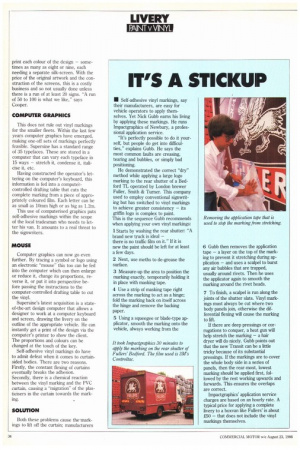IT'S A STICKUP
Page 36

If you've noticed an error in this article please click here to report it so we can fix it.
• Self-adhesive vinyl markings, say their manufacturers, are easy for vehicle operators to apply themselves. Yet Nick Gubb earns his living by applying these markings. He runs Impactgraphics of Newbury, a professional application service.
"It's perfectly possible to do it yourself, but people do get into difficulties," explains Gubb. He says the most common faults are creasing, tearing and bubbles, or simply bad positioning.
He demonstrated the correct "dry" method while applying a large logo marking to the rear shutter of a Bedford TL operated by London brewer Fuller, Smith & Turner. This company used to employ conventional signwriting but has switched to vinyl markings to achieve greater consistency — its griffin logo is complex to paint.
This is the sequence Gubb recommends when applying your own vinyl markings: 1 Starts by washing the rear shutter: "A brand new truck is ideal — there is no traffic film on it." If it is new the paint should be left for at least a few days.
2 Next, use meths to de-grease the surface.
3 Measure-up the area to position the marking exactly, temporarily holding it in place with masking tape.
4 Use a strip of masking tape right across the marking to act as a hinge; fold the marking back on itself across the hinge and remove the backing Paper.
5 Using a squeegee or blade-type applicator, smooth the marking onto the vehicle, always working from the
6 Gubb then removes the application tape — a layer on the top of the marking to prevent it stretching during application — and uses a scalpel to burst any air bubbles that are trapped, usually around rivets. Then he uses the applicator again to smooth the marking around the rivet heads.
7 To finish, a scalpel is run along the joints of the shutter slats. Vinyl markings must always be cut where two body panels join, otherwise the differential flexing will cause the marking to lift.
If there are deep pressings or corrugations to conquer, a heat gun will help stretch the marking — a hair dryer will do nicely. Gubb points out that the new Transit can be a little tricky because of its substantial pressings. If the markings are to cover the whole body side in a series of panels, then the rear-most, lowest marking should be applied first, followed by the rest working upwards and forwards. This ensures the overlaps are correct.
Inapactgraphics' application service charges are based on an hourly rate. A typical price for applying a complete livery to a boxvan like Fullers' is about £50 — that does not include the vinyl markings themselves.












































































